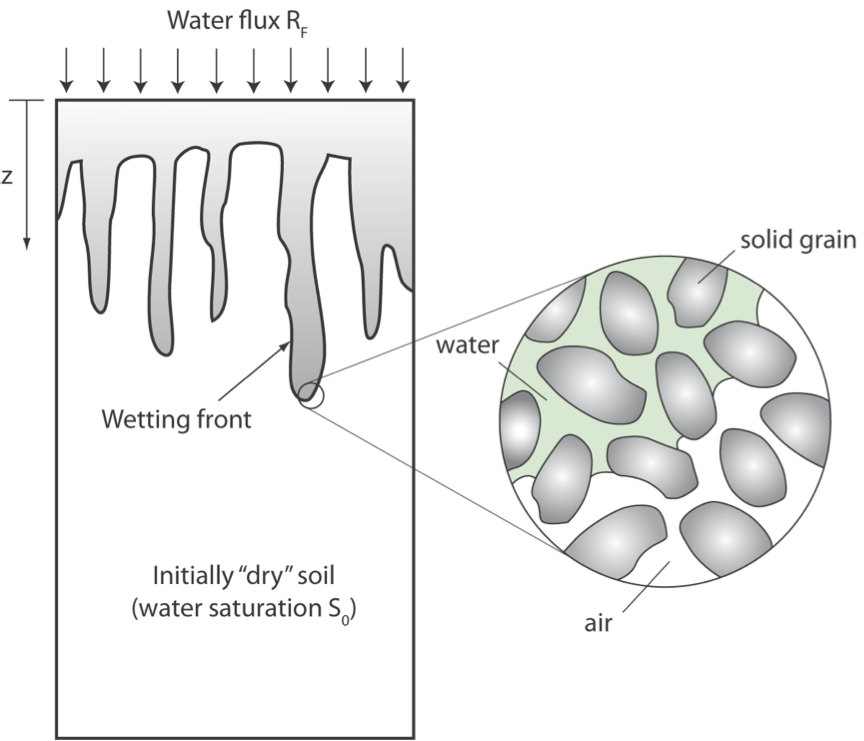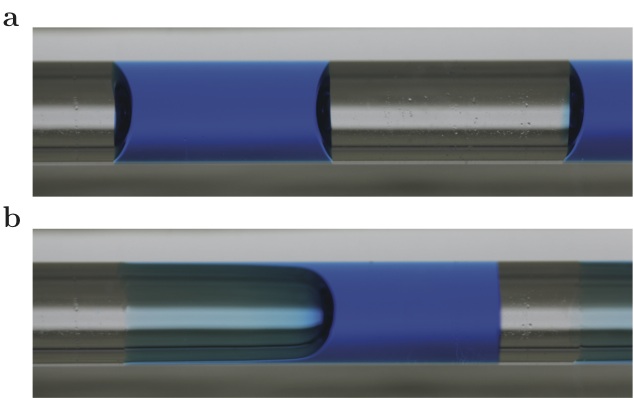Phase-field modeling of multiphase flow
Our research group has developed a new paradigm for modeling multiphase flow at the continuum scale. We proposed a phase-field formulation to model multiphase porous media flow, which recognizes explicitly that fluid-fluid displacements are out of thermodynamic equilibrium. Phase-field modeling, which originated in the 1950s in the area of solidification and phase transitions, is based on the tenet that the continuum balance equations must account for the presence of fluid-fluid interfaces. Mathematically, this is captured by a nonlocal free energy, which naturally leads to governing equations with higher-order terms. While the approach is phenomenological (in the sense that it is a purely macroscopic modeling approach), it leads—by construction—to thermodynamically consistent mathematical models.
Our approach opens the door to modeling a whole range of phenomena that were inaccessible to existing continuum models. For example, our framework has already allowed us to model gravity-driven fingering during infiltration, a phenomenon that leads to the creation of preferential flow paths when water infiltrates into dry soil, even if the medium itself is homogeneous. Despite the fact that this phenomenon is pervasive in nature and had been characterized extensively in the laboratory, it had remained elusive to current mathematical models. Following a phase-field methodology, the presence of a macroscopic interface—the wetting front—leads to an additional term in the system’s energy whose magnitude scales according to the relative strength of gravity-to-capillary forces. The new model is able to quantitatively predict the characteristics of fingered flow observed in laboratory experiments. Capturing this fingering instability is important because it can exert a powerful control on evapotranspiration, and allow for the presence of subsoil water and deep drainage fluxes in arid and semiarid climates, where potential evapotranspiration far exceeds mean annual precipitation.
The fundamental limitations of traditional theories of multiphase flow are exposed with a minimal-ingredients setting: the flow of two phases (like air and water) in a capillary tube. At static equilibrium, partial wetting leads to compactons: non-spreading structures like drops and bubbles. Given that the geometry of the flow is essentially one-dimensional, one would like to describe the phenomenon also with a 1-D model. It is surprising, and disturbing, that this is not possible with current theories of multiphase flow. Our phase-field approach has allowed us to model the statics and dynamics of multiphase flow in a capillary tube in the partial-wetting regime. Beyond its intrinsic interest, this work has paved the way to fundamental advances in understanding and macroscopic modeling of partial wetting in thin-film flows and multiphase flows in porous media.
Representative publications
Nonlocal interface dynamics and pattern formation in gravity-driven unsaturated flow through porous media.
L. Cueto-Felgueroso and R. Juanes, Physical Review Letters, 101(24), 244504 (2008), doi:10.1103/PhysRevLett.101.244504.A phase-field model of unsaturated flow.
L. Cueto-Felgueroso and R. Juanes, Water Resources Research, 45, W10409 (2009), doi:10.1029/2009WR007945.Macroscopic phase-field model of partial wetting: bubbles in a capillary tube.
L. Cueto-Felgueroso and R. Juanes, Physical Review Letters, 108, 144502 (2012), doi:10.1103/PhysRevLett.108.144502.

